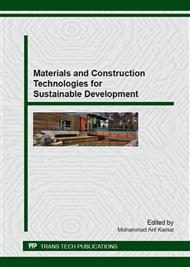[1]
Bui, Q. B., Morel, J. C., Venkatarama, B. V., & Ghayad, W. (2009, May). Durability of rammed earth walls exposed for 20 years to natural weathering. Building and Environment, 44(5), 912-919.
DOI: 10.1016/j.buildenv.2008.07.001
Google Scholar
[2]
SireWall Inc. (n. d. ). Insulated rammed earth - what is sirewall? Retrieved 3 16, 2105, from SireWall: http: /www. sirewall. com/about/sirewall-system.
DOI: 10.1533/9780857096166.5.735
Google Scholar
[3]
Cianco, D. (2011). Use of rammed earth in aboriginal remote communities of western Australia: a case study on sustainability and thermal properties. University of Western Australia , School of Civil and Resource Engineering, Crawley.
Google Scholar
[4]
Benhelal, E., Zahedi, G., Shamsaei, E., & Bahadori, A. (2013, July). Global strategies and potentials to curb CO2 emissions in cement industry. Journal of Cleaner Production, 51, 142-161.
DOI: 10.1016/j.jclepro.2012.10.049
Google Scholar
[5]
The Edmonton Journal. (2007, November 18). Ancient rammed earth technology solidly green. Retrieved from Canada. com: http: /www. canada. com/story. html?id=35970de2-b5fb-41a6-b755-9b5cf9dea936.
Google Scholar
[6]
University of Victoria . (2008, August). First Peoples House Brochure . Retrieved from First Peoples House: http: /web. uvic. ca/fphouse/pdf/first-peoples-house-brochure-Aug08. pdf.
Google Scholar
[7]
Liang, R., Hota, G., Lei, Y., Li, Y., Stanislawski, D., & Jiang, Y. (2013, January). Nondestructive Evaluation of Historic Hakka Rammed Earth Structures. Sustainability, 5, 298-315.
DOI: 10.3390/su5010298
Google Scholar
[8]
Proceq . (2015). Operating Instructions Original Schmidt. Retrieved 4 2015, 6, from Proceq: http: /www. proceq. com/en/site/downloads/Original%20Schmidt. html.
Google Scholar
[9]
Mikron Instrument Company Inc. (2012). Table of emissivity of various surfaces. Retrieved from http: /www-eng. lbl. gov/~dw/projects/DW4229_ LHC_detector_analysis/calculations/ emissivity2. pdf.
Google Scholar
[10]
Bergman, T., Lavine, A., Incropera, F., & Dewitt, D. (2011). Fundamentals of Heat and Mass Transfer (Vol. 7). John Wiley & Sons Inc.
Google Scholar
[11]
Hall, H., & Allinson, D. (2009, March). Assessing the effects of soil grading on the moisture content-dependent thermal conductivity of stabilised rammed earth materials. Applied Thermal Engineering, 29(4), 740-747.
DOI: 10.1016/j.applthermaleng.2008.03.051
Google Scholar
[12]
Hall, M., & Djerbib, Y. (2006, July). Moisture ingress in rammed earth: Part 2 – The effect of soil particle-size distribution on the absorption of static pressure-driven water. Construction and Building Materials, 20(6), 374-383.
DOI: 10.1016/j.conbuildmat.2005.01.035
Google Scholar
[13]
Government Of Canada. (n. d. ). Monthly Data Report, University of Victoria . Retrieved from Canadian Climate Data : http: /climate. weather. gc. ca.
Google Scholar
[14]
Cimbala, J. M. (n. d. ). Conservation of Momentum using Control Volumes. Retrieved from Fluid Mechanics Electronic Learning Supplement: http: /www. mne. psu. edu/cimbala/learning/fluid/cv_momentum/home. htm.
Google Scholar
[15]
Kryton International Inc. (2015). Krystol Internal Membrane. Retrieved 4 19, 2015, from Kryton: http: /www. kryton. com/products/krystol-internal-membrane-kim.
Google Scholar


